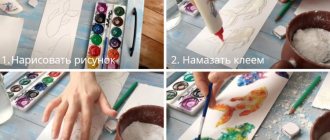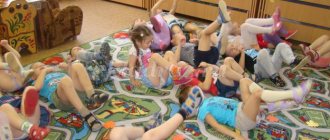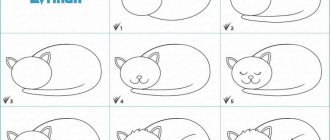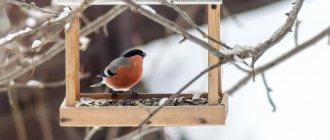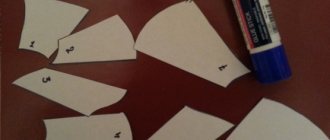On the topic: methodological developments, presentations and notes
Summary of a comprehensive lesson for children of the senior group, second period of study.
Lesson notes for the preparatory group on paper construction.
Summary of the lesson “The Arrival of Birds” on consolidating the lexical topic in the senior group of mental retardation (using mnemonics). Expanding and enriching the vocabulary on the topic; development of visual and auditory perception.
Scenario of a thematic lesson (circle “The Light of Orthodoxy”) Forty forties (bird arrival) Program objectives: - introduce children to the calendar.
Topic: “The arrival of birds.” Educational area: “Cognition,” “Artistic creativity.” Integrated educational areas: “Cognition,” “Communication,” “Physical education,” “Artistic creativity.”
This summary is intended to familiarize children with the characteristics of bird life in the spring and to instill in children a caring attitude towards birds.
In the first days of spring, you can watch the birds fly in the area with your children.
Specific options for compositions (including collective ones) within the theme
Drawing for senior group students is offered in winter (December). Traditionally, this is the composition “Birds Blue and Red” (based on the poem by the Japanese poet Kitahira Hakushu “Bird, Red Bird”). The children learn to recreate a poetic image in a drawing, choosing the appropriate color palette and beautifully arranging the birds on the base.
A little later (for example, in February), the children can be offered the composition “Birds at the Feeder” (pigeons, tits, crows, sparrows). Moreover, it can be organized as a team effort. Please note that this work must be preceded by modeling.
In winter, it would also be appropriate to draw a bullfinch or a penguin.
After sculpting the rooster (in the spring), the teacher invites the children to draw this beautiful bird. The same applies to the turkey, which is designed as a decorative composition in the form of a Dymkovo toy: children draw this bird with its tail spread like a fan and paint it with characteristic patterns. At the same time, the emphasis is placed not only on object drawing, but on developing a sense of rhythm, color and composition in the design of the pattern.
Drawing birds is good to coincide with April 1, when Fr. On this day, children can depict any bird of their choice or those that preschoolers have not yet drawn (for example, an owl, a swan, a stork, etc.).
At the end of the school year, the children can be offered a creative topic - drawing a fairy-tale bird.
Note that the plots of the drawings can be associated with outdoor games on a bird theme: for example, “Day and Night” (owl), “Dog and Sparrows.” “Birds in the Nests” “Sparrows and the Cat.” These will be plot compositions.
In addition, preschoolers really love drawing based on fairy tales. In this regard, we can offer them the following topics:
- Based on the plots of Russian folk tales: “Hen Ryaba”, “Finist - a clear falcon”, “Winged, shaggy and oily”, “Cockerel and bean seed”, “Brave cockerel” (“Zayushkina’s hut”.
- “The Swan Princess” (based on the work of A.S. Pushkin “The Tale of Tsar Saltan”).
- “Rooster and Paints” (based on the work of Vladimir Suteev)
- “Cuckoo” (illustration for a Nenets folk tale, it could be a bird with a woman’s face and hair)
Older preschoolers enjoy doing work collectively. The teacher can offer them the following topics: “Poultry farm” (poultry), “Poultry canteen”, “Duck with ducklings”, “Hen with chickens”.
Progress of the lesson:
Educator: Guys, listen to the poem:
Spring has arrived in the snow,
Calling from all over
Geese, swifts and storks,
Cuckoos and starlings .
What time of year is the poem talking about? (Spring)
.
What is the most important sign of spring? Birds come to us in spring )
.
Where do they fly from? (From warm countries)
.
What are the names of birds that fly to warmer regions for the winter and fly back in the spring? ( Migratory )
.
What migratory birds do you know ? (Rook, starling , swallow, cuckoo, nightingale)
.
Guys, pay attention to the screen.
Educator: Guys, what kind of bird ? ( Starling )
That's right,
starling . Birds delight us not only with their appearance and the wonderful colors of their plumage , but also with their songs.
In the last lesson we drew a rook , and today I invite you to draw a starling .
Look at the sequence in which we will draw the starling .
Let’s before you start work. Finger gymnastics “ The birds are flying in ”
With the coming of spring,
The birds are coming.
We spread the fingers of both hands, connect the thumbs, and wave the rest like wings.
The starlings are returning ,
And we connect the rooks near the puddle-Palms together in a cup.
The cranes are flying in a hurry, - We spread the fingers of both hands, connect the thumbs, and wave the rest like wings.
And the robin and thrush,
Educator: Well done! Now, get to work.
These are the wonderful starlings we got !
Lesson notes for the senior group “Migratory Birds” Purpose. Formation of elementary ideas in children about migratory birds through active forms and methods of children’s activities. Tasks. Priority.
Summary of an integrated lesson on speech development in the senior group “Wintering and migratory birds” Synopsis of an integrated lesson on speech development in the senior group on the topic: “Wintering and migratory birds”. Goal: clarify and expand.
Summary of educational activities for the development of speech in the senior group of the compensatory focus "Migratory birds" MUNICIPAL BUDGETARY PRESCHOOL EDUCATIONAL INSTITUTION KINDERGARTEN No. 29, AZOV Abstract of educational activities for the development of speech in the senior group.
Summary of OOD on drawing “Migratory birds are flying” with children 6–7 years old Drawing “Migratory birds are flying” Integration of educational areas: “Artistic and aesthetic development”, “Speech development”, “Cognitive.
Summary of a lesson on cognitive development in the senior group “Migratory Birds” Synopsis on the topic: “Birds” Purpose: to form the ideas of senior preschool children about migratory birds. Tasks: 1) Clarify.
Lesson summary for children of the senior group “Birds of Migratory” (by showing a collection of postage stamps) Lesson summary Purpose: To summarize and systematize children’s knowledge about migratory birds and life.
Summary of a lesson on the surrounding world in the senior group "Migratory Birds" Summary of a lesson on the surrounding world in the senior group "Migratory Birds" OBJECTIVES Educational: · Summarize children's knowledge about migratory birds.
Summary of a lesson on speech development in the preparatory group "Birds of Migratory" Summary of educational activities for the development of speech in the preparatory group "Birds of Migratory" Age of children: 6-7 years old Goals: improving grammatical structure.
Summary of a lesson in the preparatory group “Migratory Birds” Migratory birds, summary of a lesson on familiarization with nature Summary of a lesson on familiarization with nature in the senior group, topic: “Migratory.
Source
GCD move:
The teacher calls the children to him and a recording sounds with the voices of different birds. The children listen carefully. Then the teacher asks the children to name what they heard.
the birds have flown to us . toy bird appears in the teacher’s hands ; together with the children, the teacher examines the toy and names the body parts).
All birds come to us in the spring from warm countries. So our bird flew to us from warm countries. She really wants to make friends with you and play with you. What do you want? (Yes)
Great!
Conversation about the bird :
Do you like the bird ? (Yes)
What bird ? (small, beautiful)
.
What can a bird ? (fly)
.
What does a bird have to fly? (wings)
.
What else can a bird ? (sing)
.
How does the bird ? (loudly, loudly, cheerfully)
.
Educator: Well done! And now, guys, I suggest playing with the bird .
Game " Birds in Nests "
The game is repeated 1-2 times at the request of the children.
Drawing birds:
Educator: Guys, I suggest you draw small birds with the help of your palms , they will sing and we will all have fun.
(Children complete the task, the teacher controls and helps)
Educator: Guys, while your drawings are drying, you come to me and we will wash your hands.
Using your imagination and imagination, see the silhouettes of birds in the handprints. Then the children add a beak , crest, scallop, paws, eyes and other elements to the image, if desired, and show their work to each other.
